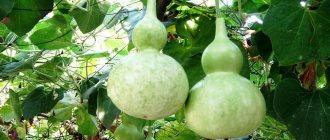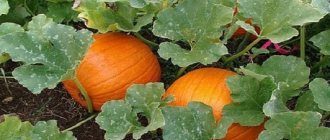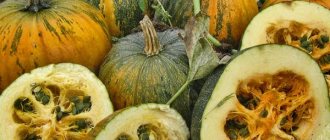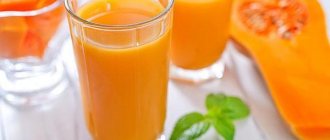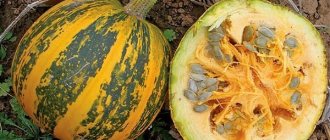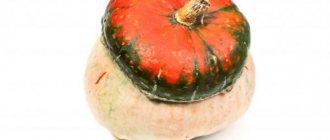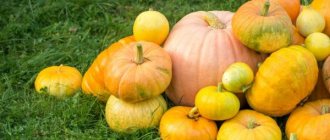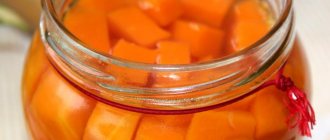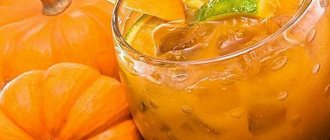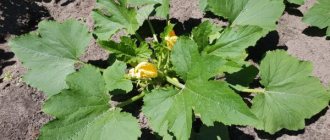Vegetable growing » Pumpkin
1
591
Article rating
Kira Stoletova
Sometimes disputes arise about what a pumpkin is – is it a vegetable, a fruit or a berry? This issue needs to be approached from different points of view. According to botanists, it is, rather, a berry, exactly the same as tomatoes or watermelons. But for a gardener or cook, it is rather a vegetable. It should be assumed that the controversy on this topic is purely terminological.
What is pumpkin: vegetable, berry or fruit
What are pumpkin plants?
Cucurbitaceae is a large plant family with more than 600 discovered species. They grow in the wild mainly in warm climates, but modern hybrids are capable of producing crops even in cold countries. On the European continent, the distribution of pumpkin closely coincides with the boundaries of oak growth.
Europe is the richest in pumpkin variety (54 genera are represented). In America you can find no more than 7 genera.
Most of the known pumpkin species are perennial or annual herbs. However, a small part is classified as subshrubs and shrubs, and only a single species is a woody form. This is Dendrosicius - a very rare plant found exclusively on the island of Socotra (endemic).
Common
Pumpkin
Herbaceous annual plants grown for human or pet consumption and for ornamental purposes. The most famous representative is the common pumpkin.
It is known that the Aztecs actively used pumpkin in cooking. Moreover, they ate not only fruits, but even flowers and parts of stems.
There are more than 100 varieties of cultivated pumpkins, and they are one of the most widespread crops in the world. Species differ from each other in fruit size, ripening speed and other important characteristics.
Pumpkin is practically undemanding to growing conditions and easily grows on all types of soil (except clay). In Russia, the most common varieties are: Zorka, Rossiyanka, Mramornaya, Volzhskaya series, Winter sweet, Khersonskaya, Tsentner, Arina and some others.
It is recommended to plant pumpkin in areas where potatoes, cabbage, carrots, and onions previously grew. The germination rate is worse only if you plant the pumpkin after related crops: cucumbers, zucchini, watermelons, etc.
Zucchini
Zucchini is a bush variety of pumpkin. They are widely used as livestock feed or in cooking. The birthplace of the culture is Mexico, or rather its northern regions. There, for centuries, local Indians grew zucchini and widely used them in their diet.
For zucchini, the length of daylight is much more important than, for example, for pumpkins. If they do not have enough sun, fruiting may completely disappear.
Zucchini is eaten in a state of technical rather than biological maturity, since in the latter case the vegetables have too hard seeds.
Cucumber
Cucumbers are perhaps the most common member of the Cucurbitaceae family, the genus Cucumber. The vegetable initially spread widely across Eurasia from the tropical and subtropical regions of India. Interestingly, the fruit got its name from the Greek “aguros”, which means unripe. The culture has been known to man for several thousand years.
Cucumber fruits are eaten only in their unripe form. Otherwise, as they ripen, they lose their taste and acquire a coarser structure.
Cucumbers are the richest vegetables in water content (up to 95-97%). For this reason, they are one of the key dietary foods.
Squash
One of the most common varieties of pumpkin.
Another name for this culture is plate pumpkin. The fruits are widely used in cooking: they are stewed, boiled, fried, pickled. For the most part, the plant is found only in warm climates and does not grow at all in the wild.
Watermelon
Another very common member of the Pumpkin family, the Watermelon genus.
The fruits of the crop grow to large sizes - the largest known watermelon has grown to 159 kg (although there are varieties of dwarf watermelons). The main feature of watermelon is the high water content in the fruit. This is mainly achieved due to the branched root system, which has an excellent ability to absorb water. The root itself can reach a depth of 1 meter, and grows horizontally up to 5 meters in each direction.
Watermelon is a heat-loving plant. Its homeland is African countries of the tropical zone. Therefore, even though at the moment many hybrids have been bred based on wild species, in Russia the crop can be truly effectively grown only in the southern regions.
Melon
Melon became known to man in the countries of Central and Asia Minor, where it grew in the wild. Nowadays it is practically impossible to find wild melon, but this vegetable is constantly grown in agriculture. Especially in warm countries of Asia, Europe, and Africa.
There are even mentions of melon in the Bible.
Melon fruits are sweet, with soft, tender pulp. The most important conditions for growing melons are a large amount of heat and light, dry winds, and the absence of frost at night. However, some early ripening hybrids can be grown even in the middle zone.
Die-hard
The advantage of hard-barked varieties is their long shelf life due to their dense peel. This is also their drawback - there is not much pulp in the fruit, and a significant part of it is occupied by seeds. However, hard-barked fatties are grown throughout Russia. Here are the best varieties of this group.
Gymnosperm
Pumpkin bark is yellow with green spots. Spherical fruits of medium ripening period. The variety is especially valued for its large, nutritious, oily seeds.
Bun
An early variety, round orange fruits reach a maximum of 1.5 kg. It is stored for a long time thanks to the peel.
Smile
Bright orange round fruits. The vegetable grows up to 8, in an optimal climate up to 15 kg. Early ripening, quite sweet, well stored and transported.
Spaghetti
The fruits are greenish at the beginning of ripening, then light yellow. Similar in shape to a melon. The name was given because of the peculiarity of the pulp - during the cooking process it is divided into fibers.
Benincasa, or wax
At the beginning of growth, the pumpkin bark is greenish, during the process it becomes covered with a waxy coating, for which the variety received its second name - waxy. The fruits are very long - up to 2 m, but in cold climates they grow small.
Exotic
Zucchini
This is an Italian variety of zucchini that was bred specifically for human consumption. In general, we can say that zucchini is nothing more than a universal zucchini. The fruits have no seeds, the peel is softer and more pliable, the pulp has a delicate, rich taste.
Gorlyanka
One of the varieties of pumpkin. A characteristic feature is its very wide application. Starting from use in cooking (in an unripe state), to making vessels and musical instruments from the peel (due to the strong woody peel).
The gourd is grown mainly in the warm countries of Africa, China, Central Asia, and India.
Chayote
The Pumpkin species is native to Central America. Today, almost all the chayote produced for the world is grown in Costa Rica.
This plant was known to the Aztecs and Mayans. They consumed almost all of it as food: flowers, shoots, stems and, naturally, the fruits themselves.
Historical reference
Pumpkin has been grown for so long that it is almost impossible to determine its exact origin.
Some researchers believe that it was brought to Europe from China, while others consider its homeland to be South America.
But, in fact, it is almost impossible to accurately determine its origin, because it is actively grown on almost all continents (except Antarctica).
Pumpkin was also common among the Aztec tribes, as evidenced by many documents. In Asian countries, one of the uses was to make vessels for liquids and even cages for small birds.
Botanical description of Cucurbitaceae
- The stem of pumpkin plants is a long shoot that mainly spreads along the ground or clings to surrounding objects with the help of tendrils, most likely modified leaves. The stems are very juicy and especially rich in water content.
- Pumpkin leaves are devoid of stipules and have petioles. They have a hard structure (the coating is either soft, hairy, or flat).
- Pumpkin flowers bloom in inflorescences or single flowers of regular shape. Structurally, they consist of a calyx and corolla fused at the base. The number of petals in different species can vary from 3 to 6. Male flowers develop 5 stamens, and they can grow together in pairs or even all together. Female flowers also have stamens, but they are sterile.
- The fruit of pumpkin is a pumpkin with a large content of seeds. Sometimes the fruits grow to enormous sizes (pumpkins, watermelons). The surface of the fruit is often hard, almost woody in strength.
- Pumpkin seeds are protein-free.
Pumpkin blossoms
Belonging to the pumpkin family, the crazy cucumber (Ecballium elaterium) is distinguished by the fact that when picked, its fruit explodes, throwing out the seeds with force.
Pumpkin varieties for Siberia and the Urals
The temperature in these areas is variable, frosts and droughts often occur, so there are several unpretentious varieties.
| Variety | Description | Ripening period | Application |
| Therapeutic. | Medium-sized fruits with a bluish color and small greenish inclusions. Can withstand temperatures down to -2 ◦C and can be stored for a long time. Capable of gaining weight up to 5 kg. | Early ripening. | Diet food. |
| Smile. | It grows in bushes on which up to 8-9 pumpkins appear. The rind is orange in color with beige longitudinal lines. It can be stored for a long time, even at room temperature it retains its rich taste and aroma. | Precocious. | Salads, soups, stews. |
| Pearl. | Quite durable with large elastic lashes. The dark yellow crust is covered with an orange fine mesh and bright markings. The pulp is reddish with an unusual pleasant taste. Gains up to 6 kg. | Late ripening. | Baking, baby food. |
Features of cultivation
The main rule that should be taken into account when growing all pumpkin plants is that initially the plants are very heat-loving and mainly came to world agriculture from hot countries, the tropical and subtropical zones of the Earth.
For Pumpkin it is important to choose the southern and southwestern parts of the site. Suitable soils: sandy, sandy loam, loamy. For good fruiting, crops must have plenty of light, and it is also advisable to choose areas for them that are well protected from the wind.
A rather important point is the choice of site for planting. It is recommended to plant pumpkin plants in places where tomatoes, potatoes, cabbage, carrots, onions, and garlic previously grew. Such crops will grow worst of all in areas where related crops previously grew: pumpkins, zucchini, cucumbers, etc.
If you grow pumpkins in the same place year after year, the yields will invariably fall each new season. This is due to the accumulation of pathogens and viral diseases in the soil.
After harvesting pumpkins, zucchini, cucumbers and other cucurbits, it is highly advisable to thoroughly plow the area to a sufficient depth. This will get rid of most of the organic residues in the soil. The root system of these plants lies quite deep and branched. If you do not remove the remaining roots, this will provoke the active development of pathogenic bacteria in the soil.
Cucumber
cucumbers
appeared in culture more than 6 thousand years ago. The homeland of this species is the tropical and subtropical regions of India and China, where it still grows in natural conditions.
Cucumber is one of the favorite vegetables, the “sworn friend” of the tomato and its eternal “rival”. This product cools perfectly in the hot season, takes part in a large number of different dishes and has a lot of useful properties.
Cucumbers are one of the most famous vegetables on the planet. They are nutritious, low in calories, used in salads, eaten raw, salted and pickled.
Useful properties of cucumber
Cucumbers are 95% water and contain very little protein, fat and carbohydrates. Cucumbers contain enzymes that promote the absorption of animal proteins. Therefore, it is useful to combine a meat dish with cucumber salad.
Cucumbers contain vitamins C, B1, B2, P, provitamin A, enzymes, aromatic and mineral substances (phosphorus, calcium, magnesium, iron). Of the mineral salts, they contain the most potassium. Cucumber fiber stimulates intestinal motor function.
Fresh cucumbers are useful for those suffering from diseases of the cardiovascular system, liver, kidneys, obesity, metabolic arthritis, and gout. Cucumbers improve appetite and have choleretic, diuretic and laxative effects.
In terms of the amount of alkaline salts, cucumber is second only to black radish. These salts neutralize acidic compounds, which are found in many foods and disrupt metabolic processes, lead to premature aging, and the deposition of crystalline compounds (stones) in the liver and kidneys.
Cucumbers, just like radishes, are called the orderly of our body for their ability to neutralize acidic compounds.
Cucumber is a very good source of iodine, and its compounds that are easily absorbed by the body. And since cucumbers contain a negligible amount of proteins, fats and carbohydrates, there is no risk of gaining weight when eating cucumbers.
For those wishing to lose weight, fresh cucumbers can help, as they delay the conversion of carbohydrates into fats. And if you eat a cucumber and wash it down with cold water or milk, you can cleanse the intestines well and quickly.
Calorie content of cucumber
Calorie content
cucumber 14 kcal.
Energy value of cucumber (Ratio of proteins, fats, carbohydrates - bzhu):
- Proteins: 0.8 g (~3 kcal).
- Fat: 0.1 g (~1 kcal).
- Carbohydrates: 2.5 g (~10 kcal).
- Energy ratio (b|w|y): 23%|6%|71%.
How to choose cucumbers
When choosing fruits, pay attention that they are not flaccid, too large or curved. The color should be even, green (or dark green depending on the variety).
The petiole should be a little lighter and firm when pressed. Also check the “crispness”, as well as the presence of a peculiar “cucumber” aroma.
If you see yellowishness, do not buy - there may be nitrates or it is an overgrown fruit. Also, for extra confidence, remove the peel and both ends before eating cucumbers, as... nitrates accumulate primarily on the surface.
Cucumbers can be smooth or with pimples. The second ones are the most delicious. Fruits with black pimples are good for all occasions (including pickling), while fruits with white ones are best eaten raw. It is advisable that the pimples are not very thick or thin.
The popularity of a particular species depends on location and time of year. The main thing when buying cucumbers is not their variety, but their quality and freshness, which can affect your health.
If you suddenly come across a cucumber with a bitter taste, don’t be alarmed - it’s not dangerous to your health. Bitterness appears as a result of heat, cold or insufficient watering, when a substance - cucurbitacin - is formed in the fruit. It is not poison.
One more thing - check for seeds in the cucumber. Their absence is an undesirable sign.
Storing cucumbers
Under normal storage conditions (dark, cool place), fresh cucumbers will last up to 5 days. You can also put it in the refrigerator, but preferably not for long, because... After about 3 days, cucumbers, like other vegetables containing a lot of moisture, may begin to rot.
Keep fruits in the refrigerator only in separate containers, wrapped in paper or in bags.
There are ways to extend the shelf life of cucumbers: you can grease them with egg white or put them in the refrigerator in a container of water with the tail down like a flower, remembering to constantly change the water. Wherever you store it, you should not allow the fruits to dry out. Also, don't keep them with apples.
The maximum shelf life can be up to 3 weeks. This requires optimal conditions: temperature 5-6 degrees Celsius, humidity 90%, in boxes, in paper. Be careful, these vegetables are sensitive to low temperatures.
For long-term storage, salting and canning technologies are used. Salted and canned ones are stored well in the refrigerator without loss of quality. For canning, it is advisable to buy cucumbers with thick skins.
When are these crops harvested?
The timing of harvesting pumpkins can vary greatly depending on the type of crop.
For example, pumpkin is one of the latest vegetables to be harvested from the garden. Pumpkins are characterized by high resistance to cold, so most gardeners try to keep them on the ground without removing them for as long as possible.
Pumpkin picking
It is important to pay attention to visual signs . As pumpkins ripen, they acquire the bright color characteristic of the variety. By the time of harvest, the pumpkin, as a rule, sucks out all the juices from the plant, causing the shoots and stems to dry out. Finally, the stalk, which connects the fruit and the stem, hardens greatly, approaching the hardness of wood. Typically, the pumpkin picking period occurs at the end of September - October .
But, for example, it is recommended to harvest zucchini before they are fully ripe. In this case, the seeds in the vegetables do not have time to ripen and they do not harden, which makes them easier to cook. The harvesting period for zucchini begins 1.5 months after they are planted in open ground .
Cucumbers also need to be picked before they are fully ripe, otherwise the vegetable will greatly lose its taste. It is better to pick cucumbers in the morning, since at this moment they contain the most moisture. If the crop was planted at the end of March (this is usually typical for greenhouses or hot climates), then harvesting can begin as early as May-June .
Watermelons are grown until their stem begins to dry out and their tendrils completely stop growing. These are the main signs that the watermelon is fully ripe and has accumulated the maximum amount of useful and nutrients. Usually this time comes in August .
Approximately the same ripening times are typical for melons.
butternut squash
Butternut squash have a pentagonal stalk with a pronounced expansion towards the base.
Butternut squash seeds are dirty yellow or brown in color.
Muscat varieties are considered the most delicious and rich in vitamins, but they have one drawback: they are all heat-loving and late-ripening, that is, they often do not have time to ripen during our short summer. Therefore, most often they are recommended to be grown only in the southern regions.
But don't rush to get upset. You can grow nutmeg pumpkins in the middle zone. Firstly, this pumpkin is grown through seedlings. The seeds are sown at the end of April, and the plants are planted in the ground in the first half of June. And secondly, nutmeg pumpkins can be removed unripe and left to ripen in the house.
Both large-fruited and nutmeg pumpkins are removed from the garden before the first frost.
Which pumpkin is best to plant? Everything, as always, depends on your preferences and goals. If you want to enjoy fried, boiled or stewed pumpkin in the summer, and only store seeds for the winter, plant more summer hard-bark varieties.
If you love pumpkin juice, baked pumpkin and want to preserve the fruits until spring, then choose large-fruited or nutmeg varieties.
If you prefer pumpkin fresh in salads, the gray-fruited varieties with sweet flesh are best for you.
The choice, as they say, is yours. And our review of pumpkin varieties and varieties will help you with this.
How to properly store pumpkin?
There are several rules to preserve pumpkin and other cucurbits for as long as possible:
- It is necessary to carefully select premises for permanent storage. It doesn't have to be a cellar. Approximate temperature background: +10-13 С. A short-term decrease in temperature is allowed, but not below +4 C. You can store pumpkins in regular rooms, but it is important to ensure that the ambient temperature does not rise above +20 C.
- It is important to maintain good ventilation in the storage location and also ensure that the vegetables are not exposed to daylight.
- Ideal storage conditions for pumpkins are laid out on dry wooden pallets, without the possibility of contact with each other or with any damp surfaces. For example, pumpkin plants do not sit well in a room where fruits that emit ethylene vapor are stored nearby: apples, pears . Alcohol in the air causes cucurbit bark to deteriorate quickly.
- The classic rule for storing agricultural crops is to periodically audit stocks. Spoiled vegetables and fruits must be removed from general storage.
Storing pumpkins
Late-ripening pumpkin varieties are stored rather poorly. Firstly, it is customary to harvest them after 4-5 months from the moment of planting, then let them sit for about 1-2 months and then eat them as soon as possible.
It is known that varieties with hard bark are stored the least. Other pumpkin varieties can be stored for quite a long time, until the next harvest. However, the more time they lie, the more taste and beneficial qualities they lose.
General information and classification
This vegetable crop, also called watermelon, is known among amateur gardeners and in industrial cultivation.
Depending on the thickness of the outer skin, all varieties of pumpkin are divided into 3 groups:
- hard-barked (the fruits are covered with a hard crust with a waxy coating, the shape of the pumpkins is elongated, cylindrical);
- nutmeg (the skin is thin, soft, and the fruits are elongated);
- large-fruited (varieties with soft skin and round pumpkins).
Large-fruited pumpkin is most often grown in home gardens. It produces very large fruits. Hard-barked pumpkin varieties are stored for a long time, but are characterized by small pumpkin sizes. The sweetest varieties belong to the butternut squash category.
All types can be divided into groups depending on their purpose:
- feed pumpkin;
- decorative varieties;
- canteens;
- pumpkin varieties for juice;
- varieties for seeds.
Application of pumpkin
The main use of Pumpkin is in cooking . Most of the species grown by humans are used for food. Porridges, stews, salads are prepared from pumpkin plants, they are used with side dishes, in soups, national dishes, and consumed raw (cucumbers, watermelons, melons). An approximately comparable share is used as feed in livestock farming.
In warm and poor countries, some varieties of pumpkin form the basis of the diet of the majority of the population. Even wild species are eaten.
Due to the high content of vitamins, some pumpkin seeds have proven themselves as medicines. For example, one of the most effective folk remedies for getting rid of worms is eating dry pumpkin seeds. And this is a proven scientific fact.
Most pumpkin vegetables contain sufficient amounts of vitamin T, which promotes the absorption of heavy foods. The fruits also contain a lot of fiber and vitamins: A, B, C, etc.
The properties of pumpkin bark, in particular its strength, are widely used by humans. Therefore, some varieties of crops are used for the production of folk musical instruments or simple vessels for water and drinks.
Sweet varieties
Among the pumpkin representatives, there are species that are especially sweet. They are often used as an ingredient in a variety of desserts. These include:
- Winter sweet;
- Sweet tooth;
- Pumpkin Graceful;
- Kapitoshka;
- Hokkaido;
- Gray Volga;
- Honey;
- Sweetie.
Winter sweet
This variety has an interesting appearance. Sweet winter squash has blue-on-green skin. Pumpkins are large. Weighing up to 12 kg. The surface of the fruit has segments. The flesh is orange. The fruit tastes sweet and has a pleasant smell.
Sweet tooth
This species is characterized by early ripeness. The taste is not very pronounced, but the appearance is suitable for table use. It contains a lot of starch, but little water and sugars. therefore, the pulp is quite fibrous and dry. The skin of the fruit is dark green.
Gray Volga
This representative has a skin of an unusual color. Several gray fruits are formed on the plant. The species belongs to the group of medium ripeness.
- weight up to 20 kg;
- oblate shape;
- transports well;
- exposed to negative effects during storage.
Honey
It is characterized by the presence of honey flavor. Advantages:
- sweet with a pleasant aroma;
- big pumpkin;
- a large amount of juice.
This variety is used for confectionery and juice.
Sweetie
Description of the Candy pumpkin resembles the characteristics of the honey variety. Pumpkins are not very large. A distinctive feature is resistance to cold climates.
Beneficial features
Like any vegetables, pumpkin contains many useful micro- and macroelements. Regular consumption of them will allow you to get rid of toxins in the body, improve metabolism and even carry out high-quality prevention of parasites.
Pumpkin is rich in vitamins A, B, C, as well as rare vitamins E and K (good for the blood, improves clotting). Pumpkin is one of the few vegetables containing vitamin T. It promotes better absorption of food and the removal of excess fats from the body.
Pumpkin seeds are known to be extremely useful in the fight against tapeworms.
Pumpkin seeds
Watermelons are extremely rich in potassium, sodium, magnesium, iron, and phosphorus salts. For this reason, watermelon pulp is useful for hematopoietic processes, digestion, normalizes metabolism and removes toxins from the body. Watermelons contain light sugars and a lot of water, which helps improve liver function.
Zucchini is incredibly rich in composition in terms of the number of useful elements . It is precisely because of this that they are called a medicinal product and are recommended for inclusion in the diet of many modern diets.
Zucchini contains a lot of vitamins A, B, C, H, E, PP. The fruits are rich in fiber content, as well as the following microelements: iron, magnesium, sodium, calcium. The vegetable pulp has an almost ideal combination of fats, proteins and carbohydrates.
Despite the fact that cucumbers consist almost entirely of structured water, the vegetables still contain many useful elements. For example, cucumbers contain carotene, chlorophyll, sugar, vitamins C, B and PP. It has been proven that including cucumbers in the diet every day improves the quality of gastric juice and stimulates better functioning of the gastrointestinal tract in general.
Pumpkin seeds are recommended to be included in the diet to reduce symptoms or treat the following chronic and viral diseases:
- liver and kidney diseases;
- diseases of the gastrointestinal tract and for treatment of parasites (recommended only with a doctor’s permission);
- diabetes;
- atherosclerosis;
- hypertension;
- menopause;
- colds.
Figleaf pumpkin (Cucurbita ficifolia)
The Peruvian jungle is home to another type of pumpkin, which, unlike the plants already described, is a perennial crop.
Externally, a green pumpkin, on the surface of which a whitish fancy pattern is clearly visible, when cut, looks more like an unripe watermelon. The oval or elongated fruit of the figleaf pumpkin has rough white or yellowish flesh with a sweetish aroma and taste. The seeds also resemble watermelon in both shape and hard black shell. The plants are vigorous, climbing, individual shoots reach 10 meters in length.
Green pumpkins of this type are used in vegetable side dishes, subjected to heat treatment, and ripe ones are a raw material for confectionery and alcoholic beverages. Despite its tropical origin, this type of pumpkin, as in the photo, can be easily grown even in the North-West of the country.
Harmful properties
Pumpkin vegetables bring a lot of positive benefits to any body, but there are still situations when they should either be completely excluded from the diet or the amount of consumption reduced:
- in the presence of chronic or temporary disorders of the stomach and intestines;
- stomach or duodenal ulcer;
- allergy;
- hypotension;
In addition, it is recommended to exclude pumpkins during breastfeeding and not to include them in the diet of children under six months.
Zucchini
Zucchini
- an annual herbaceous plant of the Pumpkin genus of the Cucurbitaceae family, a variety of common pumpkin. The fruits are oblong and green, yellow or white. This is an easily digestible and healthy vegetable product that has a good effect on digestion and skin health.
Zucchini - bush form of pumpkin
. Their homeland is America (Mexico), where zucchini was grown 3000 BC. They appeared in Europe in the 16th century, at the same time as the pumpkin. Currently, they are grown in many countries around the world.
In a fresh state, the fruits are used for quite a long time throughout the year - from spring (greenhouse zucchini) until autumn, when all types planted in open ground ripen.
Zucchini tastes good. They are used for food both fresh (slightly unripe) and in processed form - boiled, fried, stewed. They marinate well, acquiring a unique taste. Various canned foods are made from zucchini (zucchini caviar, fried and stuffed zucchini).
One of the varieties of zucchini is Zucchini.
is a popular European variety that has a slightly different shape and a variety of colors (mostly yellow and dark green).
The benefits and harms of zucchini
The composition of different varieties of zucchini is almost the same.
Zucchini contains 94.5% water, 0.6% protein, 5.2% carbohydrates, some of which are sugars, containing very little sucrose. They are rich in mineral salts, which are very important for metabolism in the human body. In larger quantities there are potassium salts - 309 mg%, phosphorus - 28.2 mg%, calcium - 17.2 mg%, magnesium - 16.7 mg%, and in smaller quantities - salts of sodium, iron, sulfur and others.
In addition, they also contain microelements - molybdenum, titanium, aluminum, lithium, zinc, etc. Zucchini contains various vitamins: 23 mg% vitamin C, as well as carotene (provitamin A), vitamins B1, B2, nicotinic acid and others.
Zucchini is one of the most common dietary products: after all, it has a record low calorie content. In terms of nutritional value, this vegetable is close to cucumbers.
The medicinal properties of zucchini have a beneficial effect on the entire human body. Zucchini gently stimulates the functioning of the stomach and intestines and heals mucous membranes, normalizes intestinal microflora, is a mild diuretic, and helps digest proteins.
The dietary fiber of fresh zucchini is able to absorb and remove toxins, excess water and salts from the body, so they are especially useful for people prone to swelling and obesity.
Zucchini is a good prevention of cardiovascular diseases. In addition, zucchini has antiallergic, antianemic and choleretic properties.
Zucchini has a positive effect on blood formation,
Zucchini is contraindicated for gastrointestinal diseases. In addition, it is not recommended to consume zucchini if you have kidney disease.
Calorie content of zucchini
Calorie content
zucchini 24 kcal.
Energy value of zucchini (ratio of proteins, fats, carbohydrates - bju):
- Proteins: 0.6 g (~2 kcal).
- Fat: 0.3 g (~3 kcal).
- Carbohydrates: 4.6 g (~18 kcal).
- Energy ratio (b|w|y): 10%|11%|77%.
How to choose zucchini
To buy a good zucchini, choose a young one, preferably a little unripe. Feel the peel carefully - it should be tender, look fresh, without cracks. If you can pierce it (you can use your fingernail), try it - it should pierce easily.
The length of the zucchini should be no more than 15-20 cm. Thickness - up to 7 cm. The weight of a good zucchini usually does not exceed 250-350 g. Too large a size indicates that the vegetable is overripe.
Unlike melons, the tail of zucchini should be green. The peel should not be thick and hard (with the exception of winter varieties). At the same time, we must not forget that the vegetable must be dense and weighty.
The European variety of squash - zucchini, although it looks somehow exotic and foreign, is now often grown by domestic producers. Therefore, advice to the buyer is to choose domestic zucchini rather than imported ones.
Storing zucchini
Zucchini will keep well at 0-5 degrees Celsius and 85% humidity for about 2 weeks. In principle, it can be longer, but without preserving all the beneficial substances. Place in the refrigerator in a separate open container or in a cool, dry place.
Pay attention to the peel, it should be without defects. Zucchini with thick skins are better preserved, so winter varieties are more suitable for longer storage.
You can preserve zucchini in different ways and in different forms. First of all, you can can it or freeze it. You can freeze it in two ways: grate it (well removing excess moisture) or cut it into small pieces, removing the seeds (later it will be convenient for cooking).
Interesting Facts
- Pumpkin fruits are actually berries (like watermelon, for example). Their weight can in rare cases even exceed 100 kg! The largest pumpkin grown reached almost 600 kg in weight.
- 7,000-year-old pumpkin seeds have been found in Mexico.
- There are more than 800 different varieties of pumpkins in the world, but only 200 of them are edible.
- Pumpkin oil is especially rich in carotene, linoleic acid, selenium, vitamins A, E, K. It is beneficial for the body in terms of removing excess cholesterol. True, it takes about 35 ripe pumpkins to prepare just 1 liter of oil!
- Cucumbers and melons evolved from a common ancestor.
- The thorns on the cucumber serve to remove moisture. In the morning you can notice small droplets of water on them.
- Pimpled cucumbers in Europe are sometimes called “in a Russian shirt.”
- The Egyptians placed cucumbers in the tombs of their relatives. Cleopatra, for example, greatly revered cucumbers, repeatedly calling them “the reason for her beauty.”
- The Bible says about cucumber: “a vegetable of Egypt.”
- One cucumber bush grows from 25 to 125 vegetables.
- Watermelon can be eaten entirely. Its crust is rich in vitamin C.
- The heaviest watermelon known to man was grown in the USA. Weight was 159 kg!
- Watermelons come in not only round, but square and triangular shapes. Square watermelons (there are also square cucumbers) were developed specifically to facilitate transportation and storage.
Hybrids
These varieties are obtained by crossing several varieties of the crop at once. This makes it possible to obtain a plant with higher characteristics.
Advantages of hybrid species:
- the plant produces fruits of approximately the same size;
- the species produces high yields under any conditions;
- hybrids are practically not exposed to diseases and pests;
- self-pollinating.
Among the disadvantages it is worth noting:
- plants are demanding on the mineral composition of the soil;
- Do not over-moisten the soil;
- do not like drought;
- Additional feeding is definitely required.
Among the pumpkin crop, the best hybrid representatives are considered:
- ruddy plump f1;
- pumpkin Matilda f1;
- sweet crumpet f1;
- pineapple f1;
- pumpkin satin f1;
- hazelnut pumpkin f1.
In addition to the species that are widely used in cooking, there are decorative varieties. The most famous are “Goose in apples” and “Black”. These vegetables have an interesting appearance and will become a real decoration for your garden plot.
Pumpkin is a healthy and tasty vegetable. It adds variety to any table. Modern breeding has achieved great success in developing varieties of this crop. Each gardener will be able to choose a species that will meet all his requirements.
Pumpkin: description of the 30 best varieties
We invite you to familiarize yourself with the description of the most popular varieties of pumpkin. There are probably no summer cottages in Russia where pumpkins grow. Its history goes back many centuries. It is known that pumpkin was used by the Mayans, knowing about its healing properties. This vegetable has a great advantage over all others - it can be stored for a long time, and you can eat not only the juicy pulp, but also the healthy seed.
Content:

